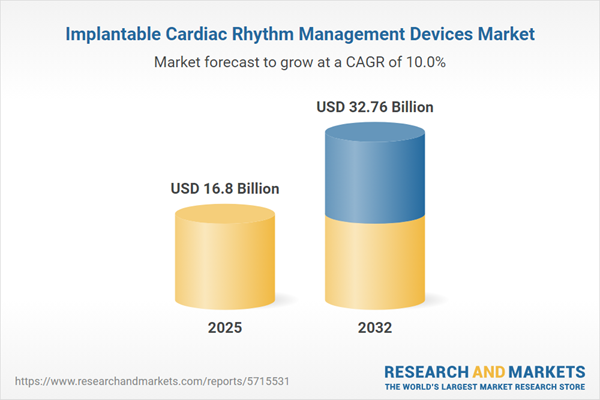Speak directly to the analyst to clarify any post sales queries you may have.
The implantable cardiac rhythm management devices market is evolving rapidly as senior leaders prioritize digital transformation, technology integration, and operational agility to adapt to new care paradigms. Successful organizations leverage innovation to achieve resilient, forward-looking growth in a highly competitive landscape.
Market Snapshot: Implantable Cardiac Rhythm Management Devices Market
Strong investments in digital connectivity and product innovation are driving expanded opportunities in the implantable cardiac rhythm management devices market. The sector achieved a valuation of USD 15.23 billion in 2024, underpinned by a compound annual growth rate of 10.04%. Projections indicate revenue could reach USD 16.80 billion in 2025, with continued gains expected through 2032 at USD 32.76 billion.
Organizations are investing in robust digital infrastructure to support communication channels, enable real-time data exchange, and enhance strategic product differentiation. Executive teams are called to adopt evidence-based decision processes that drive outperformance and efficient operational practices in an increasingly digital environment.Scope & Segmentation
This comprehensive report provides senior decision-makers with actionable perspectives on critical aspects of the implantable cardiac rhythm management devices market. Segmentation frameworks equip leaders to prioritize investments, streamline portfolio management, and adapt to shifting partner and regulatory requirements.
- Device Types: Includes cardiac resynchronization therapy devices, pacemakers, defibrillators, and implantable cardioverter defibrillators. Each category addresses targeted patient populations and compliance needs.
- Technologies: Covers biventricular, dual chamber, and single chamber systems, with each technology offering configurable pathways for procedure customization and improved patient outcomes.
- Components: Comprises atrial leads, coronary sinus leads, ventricular leads, and pulse generators. These elements influence device longevity, maintenance strategies, and procurement efficiency.
- End Users: Serves ambulatory surgical centers, cardiac specialty clinics, and hospitals—each setting requiring tailored distribution systems and distinct clinical protocols.
- Age Groups: Supports both adult and pediatric care, underscoring the importance of demographic-specific solutions and service models to achieve optimal clinical results.
- Regions: Spans Americas, Europe, Middle East and Africa, and Asia-Pacific. Regional considerations guide regulatory strategies and inform geographic prioritization for expansion and compliance alignment.
- Company Landscapes: Includes Medtronic plc, Boston Scientific Corporation, Biotronik SE & Co. KG, MicroPort Scientific Corporation, Abbott Laboratories, LivaNova PLC, and Lepu Medical Technology (Beijing) Co., Ltd. These organizations set benchmarks for market collaboration, innovation, and competition analysis.
Strategic Insights: Key Takeaways for Senior Leaders
- Accelerating digital transformation through integrated remote monitoring and artificial intelligence empowers organizations to optimize workforce readiness and extract additional value from advanced technologies.
- Collaboration between device manufacturers, healthcare providers, and regulatory agencies strengthens alignment on digital health initiatives and supports more coordinated patient care delivery.
- Customizing product design and service models to address different ages and clinical needs supports flexibility, positioning organizations to respond swiftly to shifting standards and new care pathways.
- Broadening the product portfolio and pursuing focused strategic alliances can help manage compliance complexities and market volatility, while fostering greater adaptability.
- Regional policies, shifts in reimbursement, and evolving adoption rates introduce ongoing market variability, making tailored operational strategies and risk management a necessity for sustainable growth.
Tariff Impact: Navigating Supply Chain and Cost Pressures
Tariffs on medical device components in the United States are compelling organizations to rework global supply chain strategies. Senior executives increasingly pursue nearshoring, regional manufacturing hubs, and dynamic capital investment arrangements to ensure compliance, sustain operational resilience, and adjust cost structures amid regulatory volatility.
Methodology & Data Sources
This report is built on insights from in-depth interviews with clinicians, engineers, procurement professionals, and regulatory leaders. Findings are supplemented by executive roundtable sessions and the analysis of market databases and publicly available disclosures, ensuring a robust and multifaceted market perspective.
Why This Report Matters
- Provides actionable frameworks to guide digital transformation and streamline operational processes as healthcare models shift.
- Gives clarity on the interplay of supply chain complexity, compliance demands, and dynamic operational environments, supporting better risk mitigation and planning.
- Highlights forward-looking developments, enabling executives to anticipate partnership opportunities and confidently lead organizational change with timely insights.
Conclusion
Market innovation and proactive leadership are vital for long-term success in the implantable cardiac rhythm management devices market. This report equips senior decision-makers with the insights needed to drive ongoing adaptation and achieve operational resilience.
Additional Product Information:
- Purchase of this report includes 1 year online access with quarterly updates.
- This report can be updated on request. Please contact our Customer Experience team using the Ask a Question widget on our website.
Table of Contents
3. Executive Summary
4. Market Overview
7. Cumulative Impact of Artificial Intelligence 2025
Companies Mentioned
The companies profiled in this Implantable Cardiac Rhythm Management Devices market report include:- Medtronic plc
- Boston Scientific Corporation
- Biotronik SE & Co. KG
- MicroPort Scientific Corporation
- Abbott Laboratories
- LivaNova PLC
- Lepu Medical Technology (Beijing) Co., Ltd.
Table Information
| Report Attribute | Details |
|---|---|
| No. of Pages | 188 |
| Published | October 2025 |
| Forecast Period | 2025 - 2032 |
| Estimated Market Value ( USD | $ 16.8 Billion |
| Forecasted Market Value ( USD | $ 32.76 Billion |
| Compound Annual Growth Rate | 10.0% |
| Regions Covered | Global |
| No. of Companies Mentioned | 8 |









